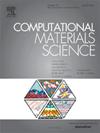揭示二维过渡金属硫族化合物基面上的电子约束以优化析氢催化:理论分析
IF 3.3
3区 材料科学
Q2 MATERIALS SCIENCE, MULTIDISCIPLINARY
引用次数: 0
摘要
二维过渡金属二硫族化合物(2D-TMDs)已成为贵金属铂的理想替代品,可用于析氢反应(HER)电催化剂。然而,它们的惰性基面存在重大挑战,有效的激活策略尚未得到充分探索。在本研究中,我们通过执行基于密度泛函理论(DFT)的第一性原理计算来解决这一差距,以开发一个全面的理论框架来激活2d - tmd的基面。我们揭示了两个关键的电子描述符-(1)最低未占据态(Elu)的能量和(2)价电子定位的程度-控制氢在基面上的吸附。这些见解形成了一种新策略的基础:将金属原子精确掺杂到Mo和w基2d - tmd的基面上。这种策略对活性位点的电子结构提供了前所未有的控制,显著增强了价电子定位,提高了HER活性。此外,我们确定了最佳的掺杂浓度,为实验研究提供了重要的指导。我们的工作提出了一种开创性的、描述符驱动的方法来激活2D-TMD基面,为HER电催化剂设计提供了变革性的见解。这项研究为开发高效的水分解技术设定了新的方向,加速了可持续氢生产的进展。本文章由计算机程序翻译,如有差异,请以英文原文为准。

Unveiling electronic constraints on basal planes of 2D transition metal chalcogenides for optimizing hydrogen evolution catalysis: A theoretical analysis
Two-dimensional transition metal dichalcogenides (2D-TMDs) have emerged as promising alternatives to noble metal platinum for hydrogen evolution reaction (HER) electrocatalysts. However, their inert basal planes present a significant challenge, and effective activation strategies have not been fully explored. In this study, we address this gap by performing density functional theory (DFT)-based first-principles calculations to develop a comprehensive theoretical framework for activating the basal planes of 2D-TMDs. We reveal two key electronic descriptors—(1) the energy of the lowest unoccupied state (Elu) and (2) the degree of valence electron localization—that govern hydrogen adsorption on the basal planes. These insights form the foundation of a novel strategy: precision doping of metal atoms onto the basal planes of Mo- and W-based 2D-TMDs. This strategy provides unprecedented control over the electronic structures at the active sites, significantly enhancing valence electron localization and improving HER activity. Additionally, we determine the optimal doping concentration, offering crucial guidance for experimental studies. Our work presents a pioneering, descriptor-driven methodology for activating 2D-TMD basal planes, providing transformative insights for HER electrocatalyst design. This research sets a new direction for developing highly efficient water-splitting technologies, accelerating progress toward sustainable hydrogen production.
求助全文
通过发布文献求助,成功后即可免费获取论文全文。
去求助
来源期刊

Computational Materials Science
工程技术-材料科学:综合
CiteScore
6.50
自引率
6.10%
发文量
665
审稿时长
26 days
期刊介绍:
The goal of Computational Materials Science is to report on results that provide new or unique insights into, or significantly expand our understanding of, the properties of materials or phenomena associated with their design, synthesis, processing, characterization, and utilization. To be relevant to the journal, the results should be applied or applicable to specific material systems that are discussed within the submission.
 求助内容:
求助内容: 应助结果提醒方式:
应助结果提醒方式:


